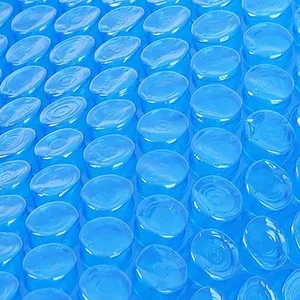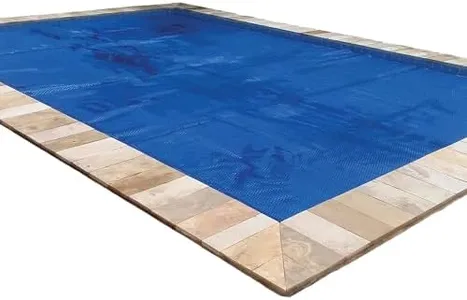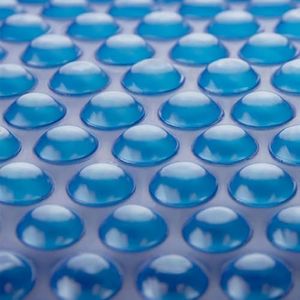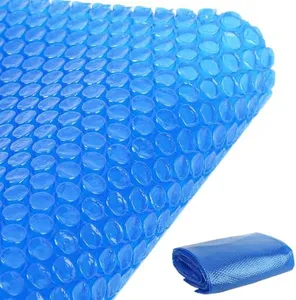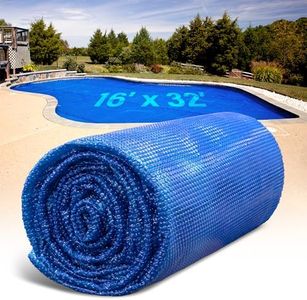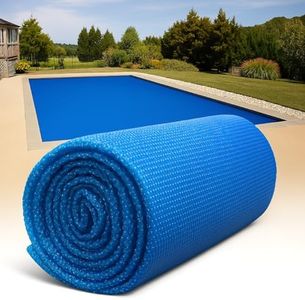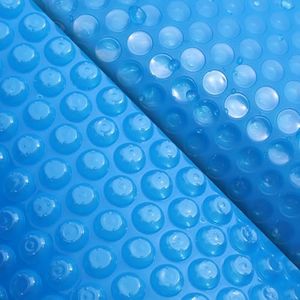10 Best Solar Pool Covers 2025 in the United States
Our technology thoroughly searches through the online shopping world, reviewing hundreds of sites. We then process and analyze this information, updating in real-time to bring you the latest top-rated products. This way, you always get the best and most current options available.

Our Top Picks
Winner
In The Swim 16' x 32' Premium Blue Rectangle Solar Pool Cover 12 Mil for Solar Heating Above Ground Pools and Inground Pools
Most important from
435 reviews
The In The Swim 16' x 32' Premium Blue Rectangle Solar Pool Cover is designed to enhance your pool experience. It is made from durable material with a 12 Mil thickness, which helps to increase the surface water temperature by up to 15 degrees. This feature can extend your pool season, making it more enjoyable for a longer period.
The light blue color of the cover strikes a balance between absorbing and retaining heat. It also helps to prevent heat loss due to evaporation during cool nights. However, it is important to note that the cover should only be used when chlorine levels are below 2.5 ppm and pH levels are above 7.2 to avoid damage. For added convenience, using a solar cover reel is recommended, as it makes removing and applying the cover easier and reduces wear and tear.
The cover is suitable for both above-ground and in-ground pools. On the downside, the cover is relatively heavy at 35.9 pounds, which might make handling it a bit challenging without a reel. Also, the cover's dimensions are quite large, so ensure it fits your pool size properly. This pool cover is a great choice for those looking to efficiently heat their pool and reduce water evaporation while extending their swimming season.
Most important from
435 reviews
In The Swim 18' x 36' Standard Blue Rectangle Solar Pool Cover 8 Mil for Solar Heating Above Ground Pools and Inground Pools
Most important from
435 reviews
The In The Swim 18' x 36' Standard Blue Rectangle Solar Pool Cover is designed for both above ground and inground pools, providing a good balance of durability and functionality. With an 8 Mil thickness, this cover is effective at increasing the water temperature by up to 10 degrees, which can help extend your swimming season. Its light blue color is optimized for heat absorption and retention, making it a practical choice for maintaining pool warmth, even during cool nights by preventing evaporative heat loss.
It is essential to maintain the pool's chemical balance, specifically keeping chlorine levels below 2.5 ppm and pH levels above 7.2, to ensure the longevity and effectiveness of the cover. The use of a solar cover reel is highly recommended to ease the process of applying and removing the cover, which also aids in reducing wear and tear. This cover is made from polyethylene, known for its durability, and weighs 32 pounds, which might require some effort to handle.
This product is especially suitable for pool owners looking for an effective heating solution that also provides some level of UV protection, while still being mindful of maintaining proper chemical levels in their pool.
Most important from
435 reviews
Sun2Solar Blue 16 ft x 32 ft Rectangle Solar Cover | 1600 Series | Heat Retaining Blanket for Rectangular Inground & Above Ground Swimming Pools | Use Sun to Heat Pool | Bubble Heating Blankets
Most important from
3278 reviews
The Sun2Solar Blue 16-Foot-by-32-Foot Rectangle Solar Cover is designed to enhance your swimming pool experience by effectively retaining heat and minimizing water evaporation. One of its standout features is the attractive blue design, made from a film of tiny bubbles that efficiently collect and retain warmth from the sun. This means you can jump into a pleasantly warm pool without the usual chill that comes with cooler water, making it ideal for families and friends looking to enjoy their pool to the fullest.
This solar cover does a great job at preventing up to 95% of water evaporation, which can be a significant advantage for pool owners concerned about water loss and maintenance costs. Additionally, it’s easy to use; the cover can be conveniently placed on and removed from the pool, allowing for more time to relax and have fun.
While the cover is designed to be trimmed for a custom fit, this could be daunting for some users who may fear damaging their product. Moreover, at 33 pounds, it might be cumbersome for a single person to handle, especially when placing it on or removing it. The material is durable and offers good UV protection, but care instructions specify gentle cleaning, which may not be as robust as other pool covers. For those with uniquely shaped pools, the trimming feature can be a boon, but it also requires a bit of confidence in cutting it to the right size without affecting the warranty.
Most important from
3278 reviews
Buying Guide for the Best Solar Pool Covers
Choosing the right solar pool cover can make a significant difference in maintaining your pool's temperature, reducing water evaporation, and keeping debris out. Solar pool covers use the sun's energy to heat your pool, making them an eco-friendly and cost-effective solution. When selecting a solar pool cover, it's important to consider several key specifications to ensure you get the best fit for your needs. Understanding these specs will help you make an informed decision and maximize the benefits of your solar pool cover.FAQ
Most Popular Categories Right Now
